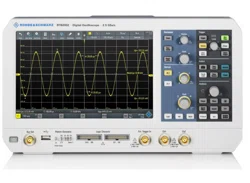Loading ...
Loading ...
Loading ...

Serial Bus Analysis
R&S
®
RTB2000
193User Manual 1333.1611.02 ─ 03
UART Trigger
Selects the trigger condition.
"Start Bit"
Sets the trigger to the start bit. The start bit is the first logical 0 after a
stop bit.
"Frame Start"
Sets the trigger to the beginning of a frame. The frame start is the first
start bit after the idle time.
"Frame Error"
The instrument triggers, if a frame error occurs.
"Symbol <n>"
Sets the trigger to the specified symbol - the n-th word - in a frame
(package). Specify the
"Symbol Offset" on page 193.
"Break"
Triggers if a start bit is not followed by a stop bit, the data line
remains at logic 0 for longer than a UART word.
"Parity Error"
Triggers on a parity error indicating a transmission error.
"Pattern"
Triggers on a data pattern at a specified position.
The pattern setup consists of the
"Symbol Offset" on page 193, the
"Numb. of Symb." on page 193, and the "Data" on page 193.
"Any Symbol"
Triggers on a pattern that occurs in one symbol at any position in a
frame.
See
"Data" on page 193.
Remote command:
TRIGger:A:UART:MODE on page 398
Symbol Offset
Sets the number of symbols to be ignored before the serial pattern after the end of the
address byte. The first symbol of interest is the first byte after the offset symbols.
The minimum offset is 0 symbol, the maximum offset is 4,095 symbols.
Remote command:
TRIGger:A:UART:POFFset on page 399
Numb. of Symb.
Sets the number of symbols (full bytes) you want to trigger on. The minimum is 1 sym-
bol, a maximum of 4 symbols is possible.
Note: Entering data bits beyond the specified length of the pattern automatically
adjusts the "Number of Bytes" to include all specified bytes.
Remote command:
TRIGger:A:UART:PLENgth on page 398
Data
Specifies the data pattern if "UART Trigger" is set to "Pattern" or "Any Symbol".
An example of pattern definition is shown in Figure 12-17.
To enter the binary value of any bit, tap this bit. To enter the hexadecimal value, tap
one of the nibbles (half byte) in the lower data line.
If a nibble (half byte) contains 1, 2 or 3 "X" bits (don't care), the nibble value is repre-
sented by the character "$". If all 4 bits of a nibble are "X", the nibble itself is "don't
care", represented by the character "X".
UART / RS232 (Option R&S RTB-K2)
Loading ...
Loading ...
Loading ...
